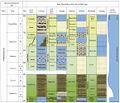Search results
Jump to navigation
Jump to search
Page title matches
- ...the past years was driven by the quiet chalk focusing on the middle Austin Chalk Group (Enverus, 2021). ...cing wells during the period (Austin Chalk Revival, 2021). The peak Austin Chalk production reached at ~ 0.12 million bbl per day in 2019-2020, mostly drive8 KB (1,200 words) - 21:22, 3 March 2022
- ...https://doi.org/10.3133/sir20125159.</ref>. Shows reservoir rocks (Austin Chalk, Tokio and Eutaw Formations outlined in red), source rocks (Eagle Ford Grou ...and northern Louisiana, contains sandstone and lignitic shales rather than chalk or limestone, and the Eutaw, located mostly in Mississippi and Alabama, con6 KB (846 words) - 20:58, 6 April 2021
Page text matches
File:M91FG200.JPG Redeposited chalk provides the main reservoir intervals in chalk fields. Resedimentation processes include sliding, slumping, debris flows,(800 × 360 (48 KB)) - 13:12, 20 August 2015
File:Figure3AustinChalk2019-20CommRept.jpg ...undiscovered, technically recoverable oil and gas resources in the Austin Chalk and related units in Texas and Louisiana. (Pitman et al., 2020).(1,789 × 1,110 (895 KB)) - 21:21, 5 April 2021
File:Figure1AustinChalk2019-20CommRept.jpg ...South Texas to Mississippi (Pearson, 2012). Shows reservoir rocks (Austin Chalk, Tokio and Eutaw Formations outlined in red), source rocks (Eagle Ford Grou(579 × 499 (288 KB)) - 20:54, 5 April 2021- ...https://doi.org/10.3133/sir20125159.</ref>. Shows reservoir rocks (Austin Chalk, Tokio and Eutaw Formations outlined in red), source rocks (Eagle Ford Grou ...and northern Louisiana, contains sandstone and lignitic shales rather than chalk or limestone, and the Eutaw, located mostly in Mississippi and Alabama, con6 KB (846 words) - 20:58, 6 April 2021

File:Figure2AustinChalk2019-20CommRept.jpg Austin Chalk production (combining Texas and Louisiana) from January 2010 through Septem(468 × 202 (56 KB)) - 21:13, 5 April 2021- ...the past years was driven by the quiet chalk focusing on the middle Austin Chalk Group (Enverus, 2021). ...cing wells during the period (Austin Chalk Revival, 2021). The peak Austin Chalk production reached at ~ 0.12 million bbl per day in 2019-2020, mostly drive8 KB (1,200 words) - 21:22, 3 March 2022
- | link1 = Austin Chalk, Tokio, and Eutaw Formations, U.S. Onshore Gulf Coast (USGS)2 KB (240 words) - 23:20, 1 February 2023
- ...number|2}}Plot of reservoir pressure vs. depth from a low-[[permeability]] chalk reservoir.<ref name=ch05r9 /> Courtesy JPT.]] ...in this example is very difficult because data are from a low-permeability chalk reservoir. Reliable pressures are difficult to obtain in low-permeability r6 KB (849 words) - 17:55, 17 February 2022
- ...in the southern [[North Sea]] Gas Basin. Four horizons are indicated: Top Chalk, Top Keuper, Top Zechstein, and Top Rotliegend. By visualizing the volume w ...ic-data_fig13-1.png|Figure 1b]], we can note that the anticline at the Top Chalk has a different trend than the anticline at the Top Keuper. Some faulting i8 KB (1,280 words) - 17:33, 25 January 2022
- ...1/0000/0017.htm Fracture development and mechanical stratigraphy of Austin Chalk, Texas]: AAPG Bulletin, vol. 71, no. 1, p. 17–28.</ref> change ductility.4 KB (510 words) - 15:22, 30 March 2022
- ...creates diapirs that form petroleum traps and migration paths in fractured chalk. ...rock ranges from Permian to Neogene and consists of [[halite]], shale, and chalk. Based on volume of petroleum, the Permian to Jurassic reservoir rocks are9 KB (1,184 words) - 18:46, 3 March 2016
- ...continued salt-ridge growth, and eventual rupture of the overlying Eocene chalk along the ridge crest. Salt, squeezed out of the ridge, localized into a do ...s 62 field. Salt rises from a depth of approximately 8000 m through Eocene chalk and Miocene, Pliocene, and Pleistocene clastics to within 200 m of the seaf9 KB (1,290 words) - 21:18, 19 October 2016
- # chalk. ==Chalk==38 KB (5,571 words) - 15:31, 16 January 2024
- ...te content versus friction coefficient for low porosity sample from Austin chalk. (Corbett, 1987))]] ...in this case. The formation consists of interbedded marl and chalk, where chalk is more prone to fractures, however, the fracture intensity is dependent on23 KB (3,162 words) - 17:28, 5 December 2023
- Like many North Sea chalk reservoirs, Ekofisk field has distinctive geochemical and geophysical evide5 KB (742 words) - 17:11, 1 February 2022
- ...e Yu-Chen Zheng, Jackson School of Geosciences, UT-Austin, TX, USA [Austin Chalk] * [[Austin Chalk, onshore U.S. Gulf Coast]]9 KB (1,311 words) - 20:32, 20 September 2022
- ...cross the basin. It its unconformably above the very dark colored Fairport Chalk member of the Carlile. It is variously composed of three facies: a lower bi ...by Osmotic Pressure in Unconventional Reservoirs: Application to Niobrara Chalk and Codell Sandstone. Unconventional Resources Technology Conferece (URTeC)9 KB (1,412 words) - 21:46, 3 March 2022
- ...ng, 1991, Predicting fracture connectivity and intensity within the Austin Chalk from outcrop fracture maps and scanline data: Transactions of the Gulf Coas5 KB (644 words) - 15:30, 3 February 2022
- ...by grainstones, mud-stones, and wackestones of the Smackover Formation and chalk.5 KB (760 words) - 20:55, 31 March 2022
- ...porosities greater than 50%. During burial in normally pressured sections, chalk porosities decrease to less than 10% at depths of [[depth::1500 m]] or more6 KB (828 words) - 17:57, 17 February 2022
